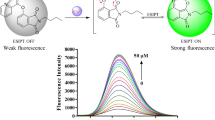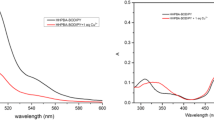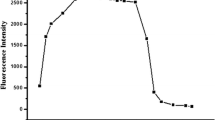Abstract
A naphthalimide Schiff base fluorescent probe (BSS) was designed and synthesized from 4-bromo-1,8-naphthalic anhydride, and its structure was characterized by 1HNMR, 13CNMR, FTIR, and MS. Fluorescence emission spectra showed that probe BSS could realize the “turn-off” detection of Cu2+ in acetonitrile solution, detection process with strong specificity and excellent anti-interference of other metal ions. In the fluorescence titration experiments, fluorescence intensity of BSS showed a good linear relationship with the Cu2+ concentration (0–10 µmol/L), and the detection limit was up to 7.0 × 10− 8 mol/L. Meanwhile, BSS and Cu2+ could form a 1:1 complex (BSS-Cu2+) during the reaction process. Under the same detection conditions, complex BSS-Cu2+ had specific fluorescence recovery properties for H2PO4− and the whole process was not only fast (6 s) but also free of interference from other anions, with a detection limit was as low as 5.7 × 10− 8 mol/L. In addition, complex BSS-Cu2+ could be successfully applied to the detection of H2PO4− in actual water samples, which with excellent application prospects.












Similar content being viewed by others
Data Availability
All data generated or analyzed during this study are included in this published article and its supplementary information files.
References
Pecorino L (2021) Molecular biology of cancer: mechanisms, targets, and therapeutics. Oxford University Press
Brady D, Crowe M, Turski M et al (2014) Copper is required for oncogenic BRAF signalling and tumorigenesis. Nature 509:492–496
Chen J, Jiang Y, Shi H et al (2020) The molecular mechanisms of copper metabolism and its roles in human diseases. Pflügers Archiv-European J Physiol 472:1415–1429
Fasae KD, Abolaji AO, Faloye TR et al (2021) Metallobiology and therapeutic chelation of biometals (copper, zinc and iron) in Alzheimer’s disease: limitations, and current and future perspectives. J Trace Elem Med Biol 67:126779
Cotruvo JA Jr., Aron AT, Ramos-Torres KM, Chang, Christopher J (2015) Synthetic fluorescent probes for studying copper in biological systems. Chem Soc Rev 44(13):4400–4414
Hinge SP, Orpe MS, Sathe KV et al (2016) Com-bined removal of rhodamine B and thodamine 6G from wastewater using novel treatment approaches based on ultrasonic and ultraviolet irradiations. Desalin Water Treat 57:1–13
Hu N-W, Yu H-W, Deng B-L et al (2023) Levels of heavy metal in soil and vegetable and associated health risk in peri-urban areas across China. Ecotoxicol Environ Saf 259:115037
Chen H, Teng Y, Lu S et al (2015) Contamination features and health risk of soil heavy metals in China. Sci Total Environ 512:143–153
Zhao M, Wang R, Yang K et al (2023) Nucleic acid nanoassembly-enhanced RNA therapeutics and diagnosis. Acta Pharm Sinica B 13(3):916–941
Wu X, Gilchrist AM, Gale PA (2020) Prospects and challenges in anion recognition and transport. Chem 6(6):1296–1309
Katayev EA, Sessler JL, Ustynyuk YA (2009) New strategy and methods for constructing artificial macrocyclic anion receptors. Selective binding of tetrahedral oxoanions. Russ Chem Bull 58:1785–1798
Vervloet MG, van Ballegooijen AJ (2018) Prevention and treatment of hyperphosphatemia in chronic kidney disease. Kidney Int 93(5):1060–1072
Sun S, Jiang K, Qian S-H (2017) Applying carbon dots-metal ions ensembles as a multichannel fluorescent sensor array: detection and discrimination of phosphate anions. Anal Chem 89:5542–5548
Yin H-B, Keng M (2014) Simultaneous removal of ammonium and phosphate from eutrophic waters using natural calci-um-rich attapulgite-based rersatile adsorbent.Desali-nation. 351:128–137
Kundu S, Coumar MV, Rajendiran S et al (2015) Phosphates from detergents and eutrophication of surface water ecosystem in India. Curr Sci 1320–1325
Sun C, Wang S, Wang H et al (2022) Internal nitrogen and phosphorus loading in a seasonally stratified reservoir: implications for eutrophication management of deep-water ecosystems. J Environ Manage 319:115681
Chen Z, Fang F, Shao Y et al (2021) The biotransformation of soil phosphorus in the water level fluctuation zone could increase eutrophication in reservoirs. Sci Total Environ 763:142976
Katano H, Ueda T (2011) Spectrophotometric determination of phosphate anion based on the formation of molybdophosphate in ethylene glycol-water mixed solution. Anal Sci 27:1043–1047
Karthikeyan R, Berchmans S (2013) Inorganic-organic composite matrix for the enzymatic detection of phosphate in food samples. J Electrochem Soc 160:73–77
Udnan Y, McKelvie ID, Grace MR (2005) Evaluation of on-line preconcentration and flow-injection amperometry for phosphate determination in fresh and marine waters. Talanta 66:461–466
Ding Q, Li C, Wang H et al (2021) Electrochemical detection of heavy metal ions in water. Chem Commun 57(59):7215–7231
Chudobova D, Dostalova S, Ruttkay-Nedecky B et al (2015) The effect of metal ions on Staphylococcus aureus revealed by biochemical and mass spectrometric analyses. Microbiol Res 170:147–156
Ahmed N, Zareen W, Zhang D et al (2022) Irreversible coumarin based fluorescent probe for selective detection of Cu2+ in living cells. Spectrochim Acta Part A Mol Biomol Spectrosc 264:120313
Chen W, Liang H, Wen X et al (2022) Synchronous colorimetric determination of CN, F, and H2PO4 based on structural manipulation of hydrazone sensors. Inorg Chim Acta 532:120760
Luo C, Zhang Q, Sun S et al (2023) Research progress of auxiliary groups in improving the performance of fluorescent probes. Chemical Communications
Yao G, Fang S, Yin P et al (2023) A colorimetric and fluorometric dual-mode probe for Cu2+ detection based on functionalized silver nanoparticles. Environ Sci Pollut Res 1–9
Xiong J, Li Z, Tan J et al (2018) Two new quinoline-based regenerable fluorescent probes with AIE characteristics for selective recognition of Cu2+ in aqueous solution and test strips. Analyst 143(20):4870–4886
Meng X, Li S, Ma W et al (2018) Highly sensitive and selective chemosensor for Cu2+ and H2PO4 based on coumarin fluorophore. Dyes Pigm 154:194–198
Arabahmadi R (2022) Antipyrine-based Schiff base as fluorogenic chemosensor for recognition of Zn2+, Cu2+ and H2PO4 in aqueous media by comparator, half subtractor and integrated logic circuits. J Photochem Photobiol A 426:113762
La Y-T, Yan Y-J, Gan L-L et al (2023) A fluorescent salamo-salen-Salamo-Zn (II) sensor for bioimaging and biosensing H2PO4 in zebrafish and plants. Spectrochim Acta Part A Mol Biomol Spectrosc 303:123159
Zhao L, Chen K, Xie K et al (2023) A benzothiazole-based on-off fluorescence probe for the specific detection of Cu2+ and its application in solution and living cells. Dyes Pigm 210:110943
Zhu H, Liu C, Su M et al (2021) Recent advances in 4-hydroxy-1, 8-naphthalimide-based small-molecule fluorescent probes. Coord Chem Rev 448:214153
Xie Z-D, Fu M-L, Yin B, Zhu Q (2018) Research Progress in 1, 8-Naphthalimide-based fluorescent probes for two-photon imaging. Chin J Org Chem 38(6):1364–1376
Han C, Sun S-B, Ji X et al (2023) Recent advances in 1,8-naphthalimide-based responsive small-molecule fluorescent probes with a modified C4 position for the detection of biomolecules. TRAC Trends Anal Chem 117242
Liu Q, Li S, Wang Y et al (2023) Sensitive fluorescence assay for the detection of glyphosate with NACCu2+ complex. Sci Total Environ 882:163548
Jang H-J, Jo T-G, Kim C (2017) A single colorimetric sensor for multiple targets: the sequential detection of Co2+ and cyanide and the selective detection of Cu2+ in aqueous solution. RSC Adv 7(29):17650–17659
Acknowledgements
The authors express appreciation to the School of Materials Science and Chemical Engineering, Harbin University of Science and Technology and Institute of Petrochemistry Heilongjiang Academy of Sciences for supporting this investigation. The authors would like to thank the anonymous reviewers and he editors.
Funding
This work was supported by National Science Foundation of China (22278098, 22008045) and Natural Science Foundation of Heilongjiang Province (No. LH2021H001, LH2023B013).
Author information
Authors and Affiliations
Contributions
Shukui Pang: Conceptualization, Methodology, Investigation, Visualization, Formal analysis, Writing – original draft. Yanchao Yu & Mianyuan Wu: Conceptualization, Methodology, Resources, Writing – review & editing, Supervision. Panru Zu & Canyao Wu: Software, Investigation, Formal analysis. Wenju Wu: Writing – review & editing. Jun You: Conceptualization, Methodology, Resources, Writing – review & editing, Supervision.
Corresponding authors
Ethics declarations
Ethics Approval
This is an observational study. The Harbin University of Science and Technology has confirmed that no ethical approval is required.
Consent for Participate
Not applicable.
Competing Interests
The authors declare no competing interests.
Additional information
Publisher’s Note
Springer Nature remains neutral with regard to jurisdictional claims in published maps and institutional affiliations.
Electronic Supplementary Material
Below is the link to the electronic supplementary material.
Rights and permissions
Springer Nature or its licensor (e.g. a society or other partner) holds exclusive rights to this article under a publishing agreement with the author(s) or other rightsholder(s); author self-archiving of the accepted manuscript version of this article is solely governed by the terms of such publishing agreement and applicable law.
About this article
Cite this article
Pang, S., Yu, Y., Wu, W. et al. Synthesis and Application of 1,8-Naphthalimide Derivatives Fluorescent Probe for Sequential Recognition of Cu2+ and H2PO4−. J Fluoresc (2024). https://doi.org/10.1007/s10895-024-03692-y
Received:
Accepted:
Published:
DOI: https://doi.org/10.1007/s10895-024-03692-y




